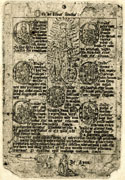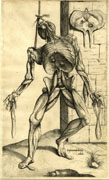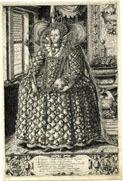Tudor beginnings
 In origin, the production of
printed images in Britain as elsewhere in Europe goes back to the late Middle Ages—to a
slightly earlier date than the introduction of moveable type which revolutionised book
production. Initially, the technique was used to produce such items as single-sheet
devotional images, and a facsimile of an example of one of these that is now lost forms part
of our corpus (bpi1008). In addition, woodcuts were used for book illustrations from an
early date, as seen in Caxton’s edition of Chaucer’s Canterbury Tales
and in books produced by Wynkyn de Worde, many of them devotional.
In origin, the production of
printed images in Britain as elsewhere in Europe goes back to the late Middle Ages—to a
slightly earlier date than the introduction of moveable type which revolutionised book
production. Initially, the technique was used to produce such items as single-sheet
devotional images, and a facsimile of an example of one of these that is now lost forms part
of our corpus (bpi1008). In addition, woodcuts were used for book illustrations from an
early date, as seen in Caxton’s edition of Chaucer’s Canterbury Tales
and in books produced by Wynkyn de Worde, many of them devotional.
The 1530s and 1540s saw something of a breakthrough. First, a new genre was introduced into
England at the hands of the artist Hans Holbein in the form of the illustrative title-page.
Holbein’s title-page was for Coverdale’s English Bible of 1535, and this was to become a
characteristic type of printed image for the rest of the 16th and 17th centuries; in it, an
attempt was often made to summarise the content of a book in pictorial form.
 Secondly, it was at this time that the first
printed images were produced from engravings made in metal, the pioneer being Thomas
Geminus, a medical figure probably of Flemish extraction, who produced a version of the
plates from Vesalius’ famous De humani corporis fabrica which was
published in London in 1545. Various plates from this book are in our corpus, including a
rather striking view of a flayed man displaying his muscles hanging from a rope (bpi1038).
Secondly, it was at this time that the first
printed images were produced from engravings made in metal, the pioneer being Thomas
Geminus, a medical figure probably of Flemish extraction, who produced a version of the
plates from Vesalius’ famous De humani corporis fabrica which was
published in London in 1545. Various plates from this book are in our corpus, including a
rather striking view of a flayed man displaying his muscles hanging from a rope (bpi1038).
In the Elizabethan period, book illustration reached a climax which was long unsurpassed
with John Foxe’s Actes and Monuments. This used illustrations on an
unprecedented scale and with great effectiveness,
 especially in the martyrdom scenes that are such a striking feature
of the book. Other uses of printed images in the Elizabethan period were predominantly
cartographic, perhaps most famously in Saxton’s Atlas of England and
Wales, while equally notable were the Armada charts produced by Augustine Ryther, which
are included in our database. The other principal type of printed image, at this time as
later, were portraits, of which some of the most notable were of Elizabeth I herself.
especially in the martyrdom scenes that are such a striking feature
of the book. Other uses of printed images in the Elizabethan period were predominantly
cartographic, perhaps most famously in Saxton’s Atlas of England and
Wales, while equally notable were the Armada charts produced by Augustine Ryther, which
are included in our database. The other principal type of printed image, at this time as
later, were portraits, of which some of the most notable were of Elizabeth I herself.
At this point, many of the artists who produced printed images in this country were of foreign extraction, including Holbein and Geminus, who have already been referred to. Others were Protestants fleeing from persecution on the continent, such as Jodocus Hondius, but a few native craftsmen are already in evidence, such as Ryther and William Rogers, whose 1589 portrait of Elizabeth I is the first print signed and dated by a native English engraver (bpi708).